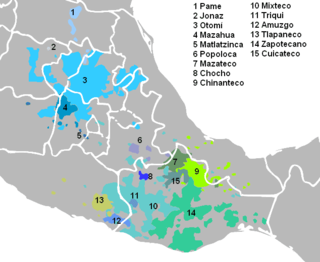| Mazatec | |
|---|---|
| En Ngixo | |
| Region | Mexico, states of Oaxaca, Puebla and Veracruz |
| Ethnicity | Mazatec |
Native speakers | 240,000 (2020 census)[1] |
Oto-Manguean
| |
| Official status | |
Official language in | In Mexico through the General Law of Linguistic Rights of Indigenous Peoples (in Spanish). |
| Language codes | |
| ISO 639-3 | Variously:maa – Tecóatlmaj – Jalapamaq – Chiquihuitlánmau – Huautlamzi – Ixcatlánpbm – Puebla Mazatecvmp – Soyaltepecvmy – Ayautlavmz – Mazatlán |
| Glottolog | maza1295 |
 The Mazatecan language, number 7 (olive), center-east. | |
The Mazatecan languages are a group of closely related indigenous languages spoken by some 200,000 people in the area known as the Sierra Mazateca, which is in the northern part of the state of Oaxaca in southern Mexico, as well as in adjacent areas of the states of Puebla and Veracruz.
The group is often described as a single language called Mazatec, but because several varieties are not mutually intelligible, they are better described as a group of languages.[2] The languages belong to the Popolocan subgroup of the Oto-Manguean language family. Under the General Law of Linguistic Rights of the Indigenous Peoples, they are recognized as "national languages" in Mexico, along with Spanish and other indigenous languages.
The Mazatec language is vigorous in many of the smaller communities of the Mazatec area, and in many towns, it is spoken by almost everyone. But in some of the larger communities, such as Huautla de Jiménez and Jalapa de Díaz, more people are beginning to use Spanish more frequently.
Like other Oto-Manguean languages, the Mazatecan languages are tonal; tone plays an integral part in distinguishing both lexical items and grammatical categories. The centrality of tone to the Mazatec language is exploited by the system of whistle speech, used in most Mazatec communities, which allows speakers of the language to have entire conversations only by whistling.
- ^ "Diferentes lenguas indígenas". cuentame.inegi.org.mx. Retrieved 2024-08-22.
- ^ Gudschinsky 1958